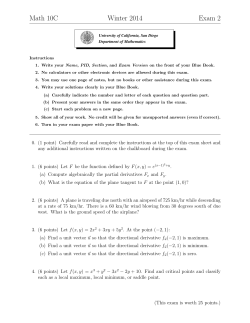
Homework 10
Homework 9 Math 151 - Spring 2015 SOLUTIONS NOTE: Since many of the problems in the textbook involve charts or graphs, I will not recopy the statements of the problems on the solutions handouts. §4.1 #2: The critical points of f (x) are the points where f 0 (x) = 0 or where f 0 (x) is undefined. On the graph, we see that we can always draw a tangent line, so f 0 (x) is never undefined. So the only critical points are where f 0 (x) = 0. These critical points occur wherever the graph of f (x) has a horizontal tangent line. These three points are marked on the graph below and identified. §4.1 #4: The critical points of f (x) are the points where f 0 (x) = 0 or where f 0 (x) is undefined. On the graph, we see that we can always draw a tangent line, so f 0 (x) is never undefined. So the only critical points are where f 0 (x) = 0. These critical points occur wherever the graph of f (x) has a horizontal tangent line. On the graph, there is one such point, which is marked on the graph below. Note that this critical point is neither a local maximum nor a local minimum of f (x). §4.1 #14: This problem asks us to find and classify the critical points of g(x) = xe−3x . To find the critical points, we first have to find a formula for g 0 (x). Using the product and chain rules, we can find that g 0 (x) = 1 · e−3x + x · (e−3x · −3). As usual, g 0 (x) is never undefined. Now we have to solve the equation g 0 (x) = 0. Normally, I say that you shouldn’t simplify formulas, but a situation like this where you need to solve an equation is an exception. After a little simplification, the equation we need to solve is e−3x (1 − 3x) = 0. The possibility e−3x = 0 has no solutions, and the possibility 1 − 3x = 0 has the solution x = 1/3. So x = 1/3 is the only critical point for this function. To test whether the critical point is a local maximum, local minimum, or neither, we can use the First Derivative Test. We need to pick one test point on either side of 1/3, so we can use x = 0 and x = 1 as test points. Plugging these numbers into g 0 (x) (NOT the original function!) gives g 0 (0) = 1 g 0 (1) ≈ −0.996. Since g 0 (x) changes from positive to negative at x = 1/3, the First Derivative Test says that x = 1/3 is a local maximum of g(x). §4.1 #18: This problem asks us to find and classify the critical points of f (x) = (x3 − 8)4 . To find the critical points, we first have to find a formula for f 0 (x). Using the chain rule, we can find that f 0 (x) = 4(x3 − 8)3 · 3x2 . As usual, f 0 (x) is never undefined. Now we have to solve the equation f 0 (x) = 0. The equation we need to solve is 4(x3 − 8)3 · 3x2 = 0. The possibility (x3 − 8)3 = 0 leads to the equation x3 = 8, which has the solution x = 2. The other possibility of 3x2 = 0 leads to the solution x = 0. So the critical points of f (x) are x = 0 and x = 2. The problem tells us to use the First Derivative Test to determine whether the critical points are local maximums, local minimums, or neither. For test points, we can use the values x = −1, x = 1, and x = 3. Plugging these numbers into f 0 (x) (NOT the original function!) gives f 0 (−1) = −8748 f 0 (1) = −4116 f 0 (3) = 740772. Since f 0 (x) does not change sign at x = 0, this critical point is neither a local maximum nor a local minimum. Since f 0 (x) changes from negative to positive at x = 2, this critical point is a local minimum of g(x). §4.1 #20: For this problem, we are required to use the Second Derivative Test. To use this test, we need to find a formula for f 00 (x). Taking the derivative of the original function, we get f 0 (x) = 4x3 −12x2 +8. Taking the derivative of this new function gives us f 00 (x) = 12x2 −24x. To use the Second Derivative Test, we have to plug the critical point directly into the second derivative. This gives us f 00 (1) = 12(1)2 − 24(1) = −12. Since f 00 (1) is negative, the Second Derivative Test says that x = 1 is a local maximum of f (x). §4.1 #28: Remember that for this problem, we are given the graph of f 0 (x), not the graph of the original function. The First Derivative Test says that f (x) has a local maximum when f 0 (x) changes from positive to negative. This happens at x = 1 in the graph. Also, the First Derivative Test says that f (x) has a local minimum when f 0 (x) changes from negative to positive. This happens at x = 3 in the graph. Although the problem doesn’t ask you about it, note that f (x) also has a critical point at x = 5 because f 0 (5) = 0. Since f 0 (x) does not change sign at this point, the critical point x = 5 is neither a local maximum nor a local minimum of f (x). §4.2 #2: The inflection points of f (x) are the points where the graph of f (x) changes concavity. There are two such points, which I have marked on the graph below. §4.2 #16: To find the critical points of f (x) = x4 − 2x2 , we examine the derivative, which is f 0 (x) = 4x3 −4x. This is never undefined, and we need to figure out where f 0 (x) = 0. To solve the equation 4x3 − 4x = 0, we can factor the left-hand side as 4x(x2 − 1) = 4x(x + 1)(x − 1), and see that the critical points are x = 0, x = −1, and x = 1. To find the inflection points, we need to examine the second derivative f 00 (x) = 12x2 − 4. We need to determine where this function changes p the equation p sign. So we first solve f 00 (x) = 0, and find that 12x2 − 4 = 0 when x = 1/3 ≈ 0.577 and x = − 1/3 ≈ −0.577. To figure out whether or not f 00 (x) is actually changing sign, we plug in some values, and calculate that f 00 (−1) = 8, f 00 (0)p= −4, and f 00 (1)p= 8. Since f 00 (x) really does change sign at both values, we see that x = 1/3 and x = − 1/3 are both inflection points of f (x). Finally, we need to determine whether each critical point is a local maximum, a local minimum, or neither. The problem says to do this using the graph of the function. If you graph f (x) = x4 − 2x2 on your calculator, you can see that it has local minimums at x = −1 and x = 1, and a local maximum at x = 0. §4.2 #18: To find the critical points of f (x) = x4 − 8x2 + 5, we examine the derivative, which is f 0 (x) = 4x3 − 16x. This is never undefined, and we need to figure out where f 0 (x) = 0. To solve the equation 4x3 − 16x = 0, we can factor the left-hand side as 4x(x2 − 4) = 4x(x + 2)(x − 2), and see that the critical points are x = 0, x = −2, and x = 2. To find the inflection points, we need to examine the second derivative f 00 (x) = 12x2 −16. We need to determine where this function changes p sign. So we first solve p the equation f 00 (x) = 0, and find that 12x2 − 16 = 0 when x = 4/3 ≈ 1.155 and x = − 4/3 ≈ −1.155. To figure out whether or not f 00 (x) is actually changing sign, we plug in some values, and 00 00 calculate that f 00 (−2) = 32, f 00 (0) = p−16, and f (2)p= 32. Since f (x) really does change sign at both values, we see that x = 4/3 and x = − 4/3 are both inflection points of f (x). Finally, we need to determine whether each critical point is a local maximum, a local minimum, or neither. The problem says to do this using the graph of the function. If you graph f (x) = x4 − 8x2 + 5 on your calculator, you can see that it has local minimums at x = −2 and x = 2, and a local maximum at x = 0. §4.2 #21: To find the critical points of f (x) = 3x5 − 5x3 , we examine the derivative, which is f 0 (x) = 15x4 − 15x2 . This is never undefined, and we need to figure out where f 0 (x) = 0. To solve the equation 15x4 − 15x2 = 0, we can factor the left-hand side as 15x2 (x2 − 1) = 15x2 (x + 1)(x − 1), and see that the critical points are x = 0, x = −1, and x = 1. To find the inflection points, we need to examine the second derivative f 00 (x) = 60x3 −30x. We need to determine where this function changes sign. So we first solve the equation 2 f 00 (x) = 0, or 60x3 − 30x − 1) = 0, and the equation has the p p= 0. Factoring gives us 30x(2x three roots x = 0, x = 1/2 ≈ 0.707, and x = − 1/2 ≈ −0.707. To figure out whether or not f 00 (x) is actually changing sign, we plug in some values, and calculate that f 00 (−1) = −30, 00 f 00 (−0.5) = 7.5, f 00 (0.5) = −7.5, and p f 00 (1) = 30. Since p f (x) really does change sign at all three values, we see that x = 0, x = 1/2 and x = − 1/2 are all inflection points of f (x). Finally, we need to determine whether each critical point is a local maximum, a local minimum, or neither. The problem says to do this using the graph of the function. If you graph f (x) = 3x5 − 5x3 on your calculator, you can see that it has a local maximum at x = −1, a local minimum at x = 1, and neither at x = 0.
© Copyright 2025









